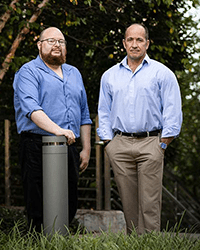Cardiac Stem Cell Therapy Improves Scar Formation Rather Than Prompting Cardiomyocyte Regeneration
|
Top Breakthrough Discovery | Published November 2019 in Nature |

Ronald Vagnozzi, PhD, and Jeffery Molkentin, PhD
Stem cell therapy helps hearts partially recover from a heart attack by triggering an immune response that results in better scar formation and improved performance of surviving tissue—not by helping hearts grow new muscle.
This finding, led by Jeffery Molkentin, PhD, Director of Molecular Cardiovascular Biology at Cincinnati Children’s, helps clarify why a number of stem cell therapy trials have produced disappointing, but not entirely negative results.
The work by Molkentin and first author Ronald Vagnozzi, PhD, reveals an unexpected way that the heart responds to cardiac stem cell injections. Instead of the stem cells being integrated into the heart to grow cardiomyocytes as originally hoped, the injections trigger inflammation and an aggressive response from the body’s macrophage cells.
“The innate immune response acutely altered cellular activity around the injured area of the heart so that it healed with a more optimized scar and improved contractile properties,” Molkentin said. “The implications of our study are very straight forward and present important new evidence about an unsettled debate in the field of cardiovascular medicine.”
Molkentin, a Howard Hughes Medical Institute professor, made headlines in 2014 with a study in Nature showing that injecting c-kit positive heart stem cells into damaged hearts as a strategy to regenerate cardiomyocytes doesn’t work. This study reveals what happens instead.





